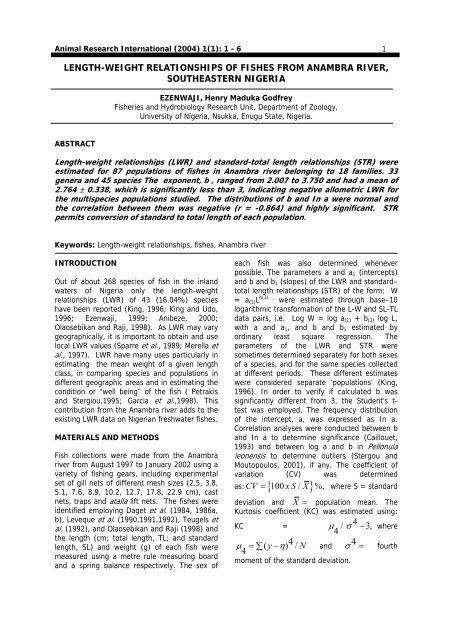Length-weight relationship of fishes from Anambra ... - Zoo-unn.org
Length-weight relationship of fishes from Anambra ... - Zoo-unn.org
Length-weight relationship of fishes from Anambra ... - Zoo-unn.org
- No tags were found...
Create successful ePaper yourself
Turn your PDF publications into a flip-book with our unique Google optimized e-Paper software.
Animal Research International (2004) 1(1): 1 - 6 1LENGTH-WEIGHT RELATIONSHIPS OF FISHES FROM ANAMBRA RIVER,SOUTHEASTERN NIGERIAEZENWAJI, Henry Maduka GodfreyFisheries and Hydrobiology Research Unit, Department <strong>of</strong> <strong>Zoo</strong>logy,University <strong>of</strong> Nigeria, Nsukka, Enugu State, Nigeria.ABSTRACT<strong>Length</strong>-<strong>weight</strong> <strong>relationship</strong>s (LWR) and standard-total length <strong>relationship</strong>s (STR) wereestimated for 87 populations <strong>of</strong> <strong>fishes</strong> in <strong>Anambra</strong> river belonging to 18 families. 33genera and 45 species The exponent, b , ranged <strong>from</strong> 2.007 to 3.750 and had a mean <strong>of</strong>2.764 ± 0.338, which is significantly less than 3, indicating negative allometric LWR forthe multispecies populations studied. The distributions <strong>of</strong> b and In a were normal andthe correlation between them was negative (r = -0.864) and highly significant. STRpermits conversion <strong>of</strong> standard to total length <strong>of</strong> each population.Keywords: <strong>Length</strong>-<strong>weight</strong> <strong>relationship</strong>s, <strong>fishes</strong>, <strong>Anambra</strong> riverINTRODUCTIONOut <strong>of</strong> about 268 species <strong>of</strong> fish in the inlandwaters <strong>of</strong> Nigeria only the length-<strong>weight</strong><strong>relationship</strong>s (LWR) <strong>of</strong> 43 (16.04%) specieshave been reported (King, 1996; King and Udo,1996; Ezenwaji, 1999; Anibeze, 2000;Olaosebikan and Raji, 1998). As LWR may varygeographically, it is important to obtain and uselocal LWR values (Sparre et al., 1989; Merella etal., 1997). LWR have many uses particularly inestimating the mean <strong>weight</strong> <strong>of</strong> a given lengthclass, in comparing species and populations indifferent geographic areas and in estimating thecondition or “well being” <strong>of</strong> the fish ( Petrakisand Stergiou,1995; Garcia et al.,1998). Thiscontribution <strong>from</strong> the <strong>Anambra</strong> river adds to theexisting LWR data on Nigerian freshwater <strong>fishes</strong>.MATERIALS AND METHODSFish collections were made <strong>from</strong> the <strong>Anambra</strong>river <strong>from</strong> August 1997 to January 2002 using avariety <strong>of</strong> fishing gears, including experimentalset <strong>of</strong> gill nets <strong>of</strong> different mesh sizes (2.5, 3.8,5.1, 7.6, 8.9, 10.2, 12.7, 17.8, 22.9 cm), castnets, traps and atalla lift nets. The <strong>fishes</strong> wereidentified employing Daget et al. (1984, 1986a,b), Leveque et al. (1990,1991,1992), Teugels etal. (1992), and Olaosebikan and Raji (1998) andthe length (cm; total length, TL; and standardlength, SL) and <strong>weight</strong> (g) <strong>of</strong> each fish weremeasured using a metre rule measuring boardand a spring balance respectively. The sex <strong>of</strong>each fish was also determined wheneverpossible. The parameters a and a 1 (intercepts)and b and b 1 (slopes) <strong>of</strong> the LWR and standard–total length <strong>relationship</strong>s (STR) <strong>of</strong> the form: W= a (1) L b(1) , were estimated through base–10logarithmic transformation <strong>of</strong> the L-W and SL-TLdata pairs, i.e. Log W = log a (1) + b (1) log L,with a and a 1 , and b and b 1 estimated byordinary least square regression. Theparameters <strong>of</strong> the LWR and STR weresometimes determined separately for both sexes<strong>of</strong> a species, and for the same species collectedat different periods. These different estimateswere considered separate ‘populations’ (King,1996). In order to verify if calculated b wassignificantly different <strong>from</strong> 3, the Student’s t-test was employed. The frequency distribution<strong>of</strong> the intercept, a, was expressed as In a.Correlation analyses were conducted between band In a to determine significance (Caillouet,1993) and between log a and b in Pellonulaleonensis to determine outliers (Stergou andMoutopoulos, 2001), if any. The coefficient <strong>of</strong>variation (CV) was determinedCV = 100 x S / X %, where S = standardas: { }deviation and X = population mean. TheKurtosis coefficient (KC) was estimated using:KC = whereµ = ( )4∑ y−η/ N4µ / σ4− 3,4σ4=andmoment <strong>of</strong> the standard deviation.fourth

















